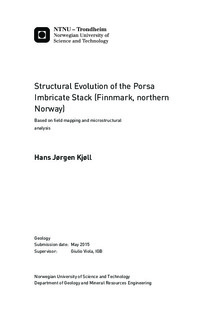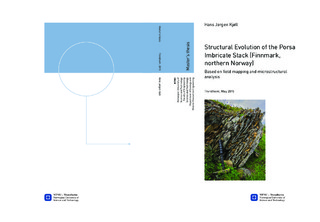| dc.description.abstract | This thesis reports the results from detailed lithological and structural mapping of the northwestern part of the RTW, which consists of a large-scale compressional imbricate stack that formed during the Caledonian Orogeny. Detailed mesoscopic and microstructural analysis of fault rocks reveal that several different processes facilitated strain localization within the stack. Early Caledonian NW SE shortening caused tightening of inherited NE SW-trending Paleoproterozic folds. Flexural slip led to ingress of fluids that promoted alteration of the host rocks and the production of phyllosilicates through extensive phyllonitization processes leading to strain localization and the formation of thrusts parallel to the folds limbs. Further deformation was accommodated by localized slip along these thrusts. A weak layer consisting of metavolcanic tuffs may have acted as a relatively strong décollement promoting the formation of primarily foreland verging thrusts. At late stages of PIS formation, a shift in deformation mechanisms caused folding of the PIS thrusts. Extensive normal reactivation of the inherited thrusts occurred during two phases of extension during the Paleozoic and the Mesozoic.
Microstructural investigations by optical microscopy and Electron Backscatter Diffraction (EBSD) of a pre- to syntectonic quartz vein deformed within the Nussirjávri Fault Zone are presented. Viscous deformation in the vein was initially accommodated by quartz basal slip. Under the prevailing deformation conditions, however, dislocation glide- and possibly creep-accommodated deformation of quartz was inefficient, and this resulted in localized strain hardening. In response to the 1) hardening, 2) progressive and cyclic increase of the fluid pressure, and 3) increasing competence contrast between the vein and the weakly foliated host phyllonite, vein quartz crystals began to deform by brittle processes along specific, suitably oriented lattice planes, creating microgouges along microfractures. Nucleated new grains rapidly sealed these fractures as fluids penetrated the actively deforming system. The grains grew initially by solution-precipitation and later by grain boundary migration. We suggest that the different initial orientation of the vein crystals led to strain accommodation by different mechanisms in the individual crystals, generating remarkably different microstructures. Crystals suitably oriented for basal slip, for example, accommodated strain mainly viscously and experienced only minor fracturing. Instead, crystals misoriented for basal slip hardened and deformed predominantly by domainal fracturing. | |

